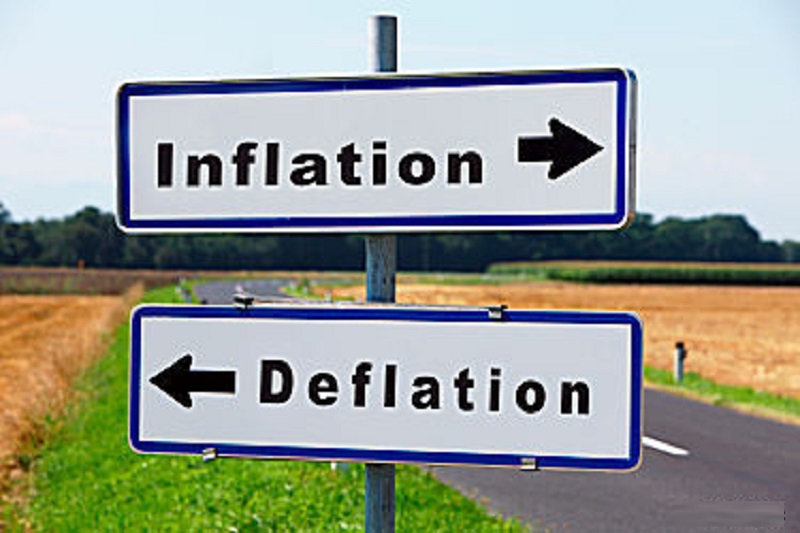Inflation in economics is the general rise in prices of goods and services in an economy. The rise in the general price level can be caused by an imbalance between market demand and supply, increase in production and transport costs. The general increase in prices (P + ΔP) of goods and services causes a reduction in the purchasing power (M / P) of the currency (M).

What is inflation and how is it measured?
The term inflation indicates the increase in price over time. To measure this increase, we use the inflation rate based on a mathematical formula that makes it possible to compare the prices of the same good in two different years.
For example, consider calculating the inflation rate of a pair of trousers which in 2005 was 100 euros and 110 euros in 2006. By inserting the value of the trouser price in 2005 (equal to P 2005 ) and of the same trousers in 2006 (equal to P 2006 ) in you get an inflation rate of 10%. This value indicates how much the price of trousers has increased (10 euros) compared to the value of the previous year (100 euros).
The calculation of the inflation rate for a single asset is very simple. To evaluate the price trend of a market that produces different goods and services it is necessary to construct a price index , ie a number, obtained on the basis of complicated mathematical formulas, which takes into consideration the prices of all goods and services in relation to their contribution to the total production of a country. In this case, the inflation rate indicates the increase in the price index over time and gives an account of the average price trend of a country.
Causes of Inflation In Economics
The causes of price inflation are many and it is not always easy to identify the source of increasing price. Inflation can also be caused by an unexpected growth in market demand that does not follow an equal growth in production (demand inflation). It can also be caused by an increase in the quantity of money (monetary inflation), a general increase in costs of inputs and raw materials (cost inflation) and the same expectation of future price growth. The different causes of inflation were analyzed by the different schools of economic thought during the twentieth century. The main causes of inflation are the following:
- Monetary inflation . Monetary inflation is the basis of the monetarist theory that in the second half of the twentieth century has attributed to the expansion of the central banks’ money supply the responsibility and cause of price growth.
- Demand inflation . Demand inflation is a classic explanation of price growth. Sudden increases in market demand can cause prices to rise if supply (production) is unable to adjust immediately to demand. This happens in situations of full employment of resources and in the delay of time necessary to adapt the productive capacity of the plants through investments. The Phillips curve originated from this point of view.
- Inflation by costs . Cost inflation, on the other hand, is a cause deriving from the increase in production costs of goods, especially in the labor and energy markets. For example, the increase in labor costs and the cost of energy raw materials (eg oil) caused price growth in the 1970s. The increase in production costs is moved forward on sales prices by companies.
- Inflation expectations . The hypothesis of inflation expectations has won the attention of economists since the 1980s, noting that in many cases the expectation of future inflation is itself a cause of price growth. For example, if companies expect future price growth over the period (t + 1), they tend to adjust sales prices upwards over the period t (present).
Other factors that can cause an inflation from costs are for example the increase of the prices of raw materials, or of labor.
Inflation in economics refers to the rate at which the general level of prices for goods and services is rising, and subsequently, purchasing power is falling. Central banks attempt to limit inflation, and avoid deflation, in order to keep the economy running smoothly.
Here’s a guide in a tabular format to understand key aspects of inflation:
| Aspect | Description |
|---|---|
| Definition | Increase in the general price level of goods and services. |
| Causes | 1. Demand-Pull Inflation: Greater demand, limited supply. |
| 2. Cost-Push Inflation: Rising production costs. | |
| 3. Built-In Inflation: Wage-price spiral. | |
| Measurement | Consumer Price Index (CPI), Wholesale Price Index (WPI). |
| Effects | 1. Decreased purchasing power. |
| 2. Distorted spending patterns. | |
| 3. Increased investment in non-monetary assets. | |
| Control Measures | 1. Monetary policy (interest rates, reserve requirements). |
| 2. Fiscal policy (government spending, taxes). | |
| 3. Supply-side measures (increase productivity). | |
| Types | 1. Hyperinflation: Extremely high, out-of-control inflation. |
| 2. Stagflation: High inflation, high unemployment, stagnant growth. | |
| 3. Deflation: General decline in prices (negative inflation). |
This table provides a basic framework for understanding the various aspects of inflation in an economic context.
Conclusion: Navigating the Complexities of Inflation
Inflation in economics is a complex phenomenon with significant implications for individuals, businesses, and policymakers alike. By understanding the causes and effects of inflation, individuals can make informed financial decisions and adjust their strategies accordingly. As we navigate the ever-changing economic landscape, keeping a close eye on inflationary trends is key to ensuring a stable and prosperous future. So, stay curious, stay informed, and stay ahead of the inflation game.
